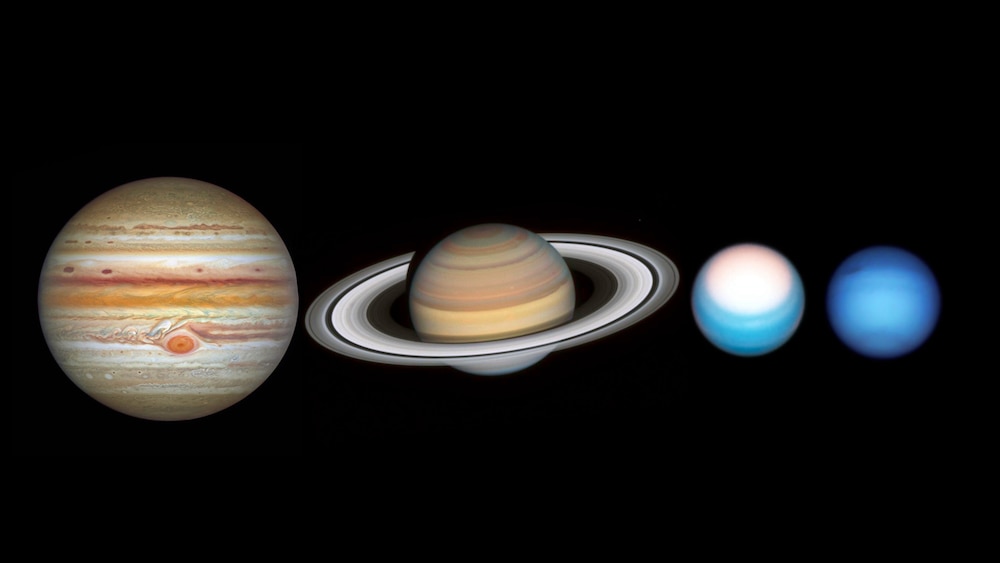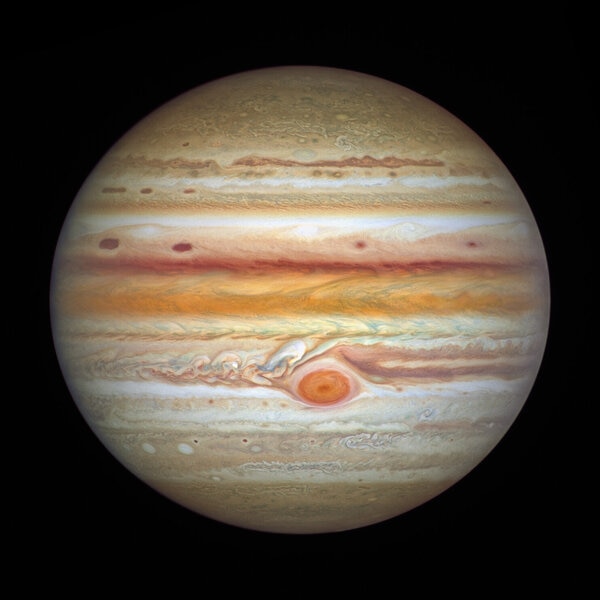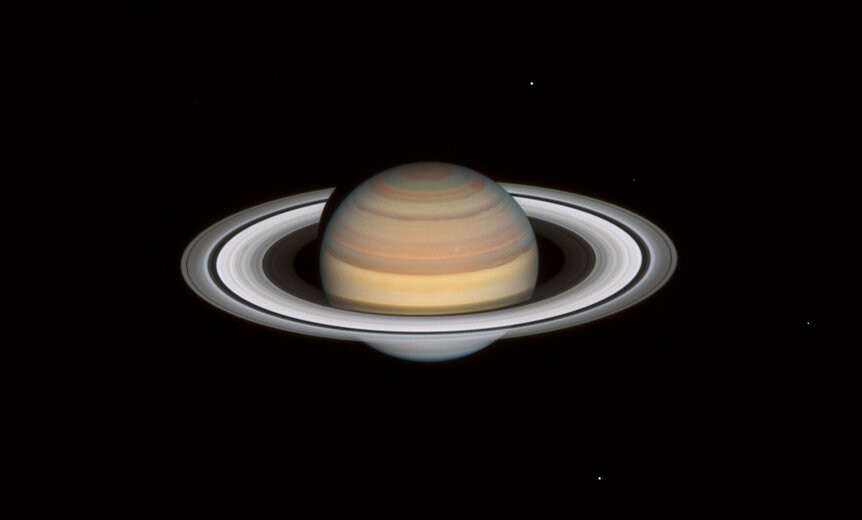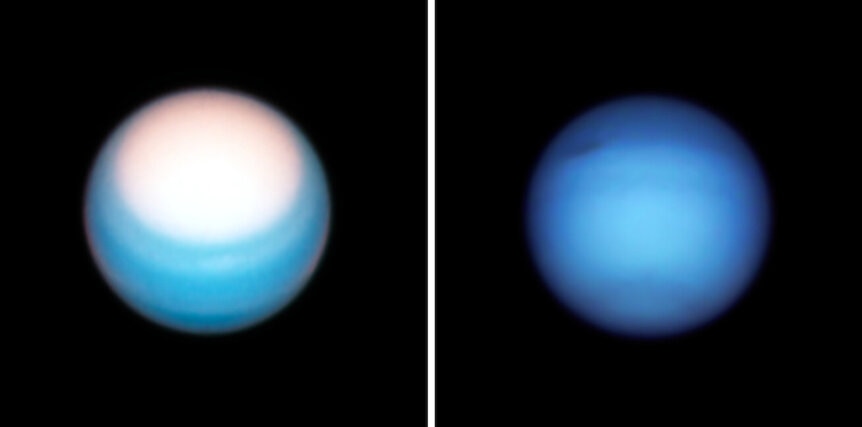Create a free profile to get unlimited access to exclusive videos, sweepstakes, and more!
Hubble takes a series of giant outer planet family portraits
Gas giant photos c/o Hubble.

Every year, Hubble Space Telescope is pointed toward each of the four giant outer planets in our solar system — Jupiter, Saturn, Uranus, and Neptune — as part of a program to monitor their atmospheres.
All four rotate rapidly, in well under one Earth day*, so images are taken over the course of several hours to be able to create global maps of the planets, allowing planetary scientists to examine as much of the planets' atmospheric systems as possible. They're also done in as close to the same way every year to provide a consistent database over time.
This is called the Outer Planet Atmospheres Legacy program (or OPAL), and every year gives us truly lovely images of these huge planets. 2021 is no exception.
First up, of course, is Jupiter, the largest planet around:
This image was taken on September 4, 2021, when Jupiter was about 605.5 million kilometers from Earth, not long after it was at opposition, the position in its orbit when it's directly opposite the Sun in our sky and closest to us.
The Great Red Spot is the most obvious feature, an ancient storm (centuries old at least) that has been the object of intense study the past few years. The Juno probe, currently orbiting Jupiter, has been using infrared imaging to peer deep into the atmosphere to understand what's going below the surface (the Spot runs at least 500 km below the cloud tops!), and Hubble observations like this one show that winds in the Spot have been increasing even as the Spot itself has been shrinking in size. These annual OPAL images will help scientists understand why all these things are happening.
Dozens of other, smaller storms are visible all across the face of the gas giant, including a barge, the long snaking brownish cloud about halfway to the pole from the equator. It's a low-pressure cyclone with warmer air in it; barges aren't usually this big and but can appear in either hemisphere. All these features interact with the atmosphere around them, changing size, shape, composition, and more. It's only through repeated regular observations that we hope to figure out what's what there.
Oh my, Saturn.
The ringed planet is obviously aptly nicknamed here, with the broad A and B rings visible and the wide Cassini Division between them. There's a somewhat thick layer of haze in Saturn's upper atmosphere that usually dulls the bands (that are so vividly seen on hazeless Jupiter), but the filters used in this image see light that passes more easily through the haze, allowing the stripes to shine.
The huge and weird (but fairly well understood) north polar hexagon can be seen in brownish red, an immense wind pattern 25,000 km across (nearly wide enough to fit two Earths inside it side by side). Geometric patterns are common in polar vortices, an outcome of how flowing air behaves in a rapidly rotating system.
Four moons are visible if you look carefully (check the image caption). The moons revolve around Saturn so rapidly that even over the course of a few hours they can scoot quite a long way; I had a hard time identifying which moon was which, but happily the NASA Hubble site has an annotated version of the completed image.†
Uranus is a weird planet. Most planets orbit the Sun with their rotational axes close to straight up relative to their orbits. Earth is a bit of an exception with a 23° tilt (Mars too with about the same inclination), but Uranus is tipped way over to 98°. No one knows why, though one idea is a massively enormous grazing impact knocked it over.
In this image the north pole of Uranus is seen to be fairly white — this is called its polar hood — most likely due to chemical changes in the atmosphere as north polar spring commences, and ultraviolet light from the Sun has a stronger effect. The fact that it's white means it's reflecting light at all wavelengths, so it may be due to methane clouds; that is, methane condensing in the atmosphere. Usually Uranus is light greenish-blue color due to methane, which absorbs red light and reflects other colors back to us. But if lots of clouds form that could change.
By the way, Uranus may smell like rotten eggs. Make of that what you will.
Speaking of methane, Neptune is the most distant major planet from the Sun — a staggering 4.3 billion km from us when this image was taken on September 7, 2021 — and its atmosphere of methane makes it a striking deep blue. We learned a lot about it when Voyager 2 passed by in 1989, including that the atmosphere can have huge dark storms. One seen by Voyager was completely gone by the time Hubble launched and took a look, but over the years more have been seen; you can spy one to the upper left in this shot.
These dark spots form in both hemispheres and tend to migrate across latitudes to the equator where they disappear. One was recently seen to do a U-turn, though, and start heading away from the equator. Their behavior is weird and not well understood.
But that's the point of these observations in the first place, isn't it? These huge worlds, dwarfing our own, are difficult to understand. They don't have surfaces like Earth, they have atmospheres hundreds of kilometers deep that merge into a liquid ocean, and behave in ways that are seriously hard to replicate in the lab. So we study their winds, their air, their cloud tops, their rings, their moons, and whatever else we can see to understand them better. And, in this way, understand Earth better, too.
One last note: If you go outside over the next few weeks and look south, Jupiter is the brightest object in that part of the sky (right now Venus dominates to the southwest). Saturn is fainter but not too far to its west. Uranus and Neptune are both up as well, though you'll need binoculars for the former and a good 'scope for the latter.
It's been ages since I've looked at them for myself through my 'scope. It's not Hubble by any means, but then knowing those photons traveled from the Sun to those planets, reflected off them, then traveled hundreds of millions or billion of kilometers back to go directly into my eye?
Yeah. That's pretty cool, too. Time to get outside.
*As a sci-fi fan for so long, being able to write "Earth day" and have it be necessary and accurate is always a bit of a thrill.
†My thanks to astronomer and planetary scientist Amy Simon (Principal Investigator for OPAL), who pointed out the annotated image to me.






























